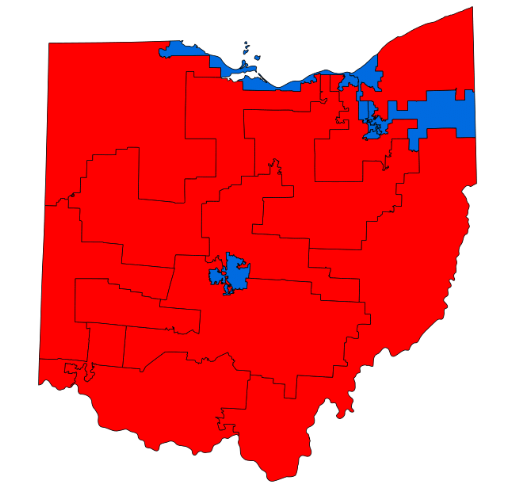What you need to know about Ohio Politics and Policy
Tyler Buchanan · March 3, 2020
The money and interests targeting Ohio’s legislature and Supreme Court in 2020
By Tyler Buchanan – Originally published February 17, 2020 in the Ohio Capital Journal
It’s not an understatement to say this November’s General Election will have monstrous implications.
Everything comes to a head in this 2020 cycle: the legislatures, the courts, the census, control of the new redistricting effort and a presidential race sure to bring immense turnout this fall.
As such, both political parties are doing everything they can in Ohio to ensure a successful November at the polls. Republicans want to maintain their power in the legislature and the courts. Democrats want to take hold of the courts for the first time in decades and put an end to partisan gerrymandering.
Various Republican and Democratic groups are targeting Ohio with political power — current and in the future — on the line.
Major political interests, from charter schools to energy companies, are pouring vast sums of money into these efforts, reporting from the Capital Journal finds.
GOP fighting to maintain control
The Republican Party sees the Ohio Supreme Court as an important cog in its effort to maintain political control. The outcome of two judicial elections this November may have a wider impact on state politics.
This is why: Ohio’s legislative districts are redrawn after each decennial census. In 2018, voters here approved a new process in which the new map will be drawn by the state legislature. The map will require bipartisan support in order to be adopted, or else a separate Ohio Redistricting Commission will draw and approve the districts.
Republicans have supermajorities (more than 60 percent representation) in both the Ohio House and Senate. Their hold on the chambers is unlikely to be challenged in this year’s elections, meaning the GOP will have a heavy hand in drawing the new map.
If there is a resulting legal battle stemming from this redistricting process, the Ohio Supreme Court may get involved. The U.S. Supreme Court ruled last year that partisan gerrymandering is an issue best adjudicated by state supreme courts.
To have a majority in both the Statehouse and the Ohio Supreme Court would give Republicans control of both ends of the process.

The Republican State Leadership Committee, an organization focused on down-ballot races at the state level, has several initiatives related to this effort.
RSLC’s Judicial Fairness Initiative specifically deals with state courts and previously named Ohio a target state in 2014 and 2016.
The leadership committee and its Judicial Fairness Initiative have each spent a considerable sum with FlexPoint Media, a New Albany company. In total, FlexPoint Media received around $900,000 to conduct “media placement” work. The company is led by Tim Cameron, a former Republican strategist who once worked for a Super PAC supporting Newt Gingrich’s 2012 presidential campaign.
(That $900,000 expenditure followed a $5,000 contribution by FlexPoint to the RSLC in early 2019, a return on investment approaching 18,000%.)
Another RSLC initiative known as Right Lines GOP is focused on winning state legislatures ahead of the impending redistricting efforts.
The Buckeye State is among 14 across the country being targeted by Right Lines GOP.
“Our Party’s success nationally depends on our Party’s success in the states,” its website notes.
RSLC conducted a similar campaign a decade ago for the 2010 redistricting cycle known as REDMAP.
The 2020 effort features a “Speakers Advisory Council” of former U.S. House Speakers Paul Ryan, John Boehner and Newt Gingrich. Ryan’s involvement led to criticism from the largest newspaper in his home state of Wisconsin, which wrote in an editorial that Ryan is “doubling down on gerrymandering that has helped his GOP.”
The impact of gerrymandering
Ohio gerrymandering has unquestionably favored Republican candidates over the past decade.

To use the 2018 elections as an example, Republicans did receive the most total votes in Ohio’s 16 Congressional districts: 52 to 47 percent. That resulted in the GOP earning 12 seats to the Democrats’ four.
The districts are drawn to produce an entrenched, unshakable lead for the political parties in their respectively held districts. In the 2014, 2016 and 2018 elections combined, only two out of 48 Congressional races in Ohio were decided within a 10 percent margin.
There has not been a flipped district in a decade, because of how compacted Democratic and Republican voters are placed in these Ohio districts.
Who is funding these GOP initiatives?
The Republican State Leadership Committee brings in tens of millions of dollars per year in contributions. According to the Center for Responsive Politics, which tracks political spending, RSLC raised well over $40 million in the 2018 election cycle. With so much on the line in 2020, a host of major corporations and right-leaning donors have donated to RSLC this cycle.
Koch Industries and interests connected to Las Vegas businessman Sheldon Adelson have been major donors to RSLC over the past decade, as have companies such as Amazon, Wal-Mart, Paypal, NASCAR, Coca-Cola, Monsanto and Raytheon.
In Ohio, top donors include Marathon Petroleum based in Findlay ($201,000 in 2019); Anthem based in Cincinnati (also $201,000); and AT&T Services ($50,000).
Others with an interest in having a friendly Ohio Supreme Court and Ohio Statehouse have also contributed money to RSLC over the years.
This includes FirstEnergy Corporation, which has donated $160,000 since 2006. FirstEnergy was involved in a legal dispute last year which led to the Ohio Supreme Court ruling that a charge FirstEnergy had imposed on customers was improper. The Court later ruled 6-1 against a motion to reconsider, with one Republican justice dissenting. That was Sharon Kennedy, whose reelection effort will be bolstered by the RSLC’s Judicial Fairness Initiative.
FirstEnergy was able to keep the hundreds of millions of dollars it had imposed on customers prior to the Supreme Court’s ruling.
FirstEnergy also has interest in keeping the Statehouse’s status quo. The corporation benefited in 2019 from the signing of House Bill 6, which subsidizes several of its power plants to the tune of $150 million per year.
The charter school industry also features high-profile supporters of RSLC. K12 Management Inc., a for-profit online charter school company, has donated more than $300,000 to the committee over the past decade, according to the Center for Responsive Politics.
K12 operates the Ohio Virtual Academy, which became the largest online charter school in the state following ECOT’s demise in early 2018. The charter benefited when it convinced lawmakers not to punish Ohio Virtual Academy for poor academic scores of former ECOT students.
One of the biggest financial supporters of K12 Management is the DeVos family. The most well-known is Betsy DeVos, who now serves as the U.S. Secretary of Education. Her husband, Richard DeVos Jr., and his three siblings, Doug, Daniel and Suzanne, are big supporters of RSLC as well — the four have donated $1.15 million to the committee since 2015.
Dem group working to position party for redistricting
The Democratic Party is also focusing its sights on Ohio, though in narrower fashion and with far less money than the Republicans.
The National Democratic Redistricting Committee is led by Eric Holder, who served as attorney general under President Barack Obama. NDRC is targeting 12 states this election cycle.
According to a filing with the IRS, the committee’s purpose is to “build a comprehensive plan to favorably position Democrats for the redistricting process through 2022.”
NDRC plans to spend millions of dollars on state legislative and judicial elections over the next nine months, though it only plans to spend a small amount in Ohio.
Each of the committee’s 12 target states outline different focuses; in Ohio, NDRC will only be supporting the House of Representatives. Republicans hold a 61-38 advantage in the House, meaning it will almost certainly have the upper hand in the map design process next year.
Still, the process will require at least 50 percent support from the minority party in each chamber.
“(A)n increase in Democratic Party representation in the legislature will help ensure more bipartisan map-drawing process,” an NDRC news release states.
The news release, publicized on Friday, outlines just over $33,000 in Ohio spending. This includes around $20,000 in spending to the Ohio House Democratic Caucus and another $13,300 to House Minority Leader Emilia Sykes, D-Akron.
NDRC has far less corporate support than its Republican counterpart, but several well-known donors have donated in the past few years. This includes George Soros, who contributed $2.6 million to the committee in 2018, an IRS filing shows.
Ohio Democrats are hoping to flip the Supreme Court, eat into Republicans’ Statehouse control and deliver a win to their party’s presidential nominee. Republicans, with a political and financial advantage headed into the remainder of 2020, hope to maintain power as the redistricting process approaches.
It will all come down to Nov. 3, 2020.
Tagged in these Policy Areas: 2020 Election | Democracy


